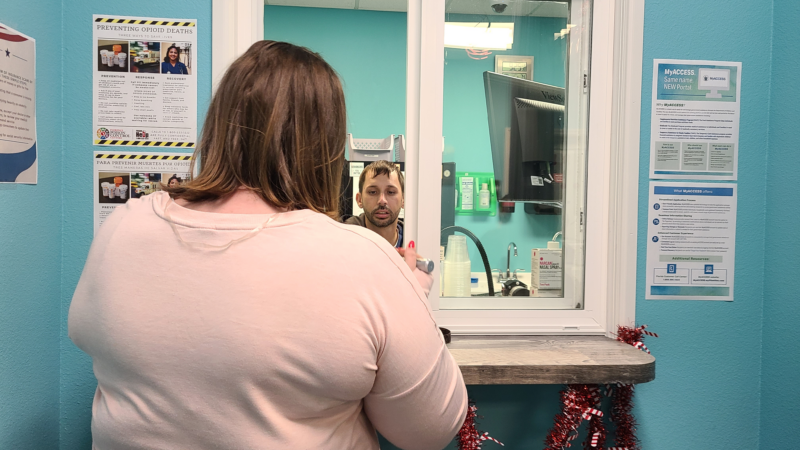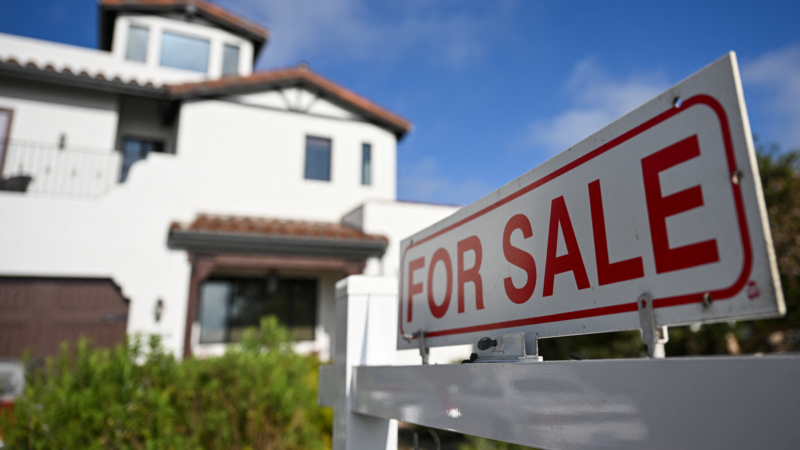For people with opioid addiction, Medicaid overhaul comes with risks
It was hard enough for Stephanie to get methadone treatment when she moved from Indiana to Florida last year. The nearest clinic, north of Tampa, was almost an hour away, and she needed help with transportation.
But at least Stephanie didn’t have to worry about affording it. Medicaid in Florida covers methadone, which reduces her opioid cravings and prevents withdrawal symptoms.
Stephanie had young children, and had trouble landing a job after the move. So even though Florida has strict eligibility rules for Medicaid, she qualified for coverage.
For nearly a decade, methadone has helped Stephanie juggle jobs and take care of her kids. Stephanie, 39, asked to be identified by her first name only, because her two youngest kids don’t know she’s in treatment for opioid addiction.
But methadone lets her “just have a normal — really normal — life,” she said. “You know, all the things that some people take for granted.”
So it was devastating when Stephanie arrived last summer at her clinic in Inverness, Florida to pick up her weekly supply of doses, and learned she had been dropped from the state’s Medicaid rolls.
Florida, like other states, was going through its data and checking the eligibility of each enrollee — part of a bureaucratic reset after the end of the pandemic.

Stephanie didn’t know why she was disqualified, but suddenly, her methadone prescription cost hundreds of dollars that she couldn’t afford.
She panicked, afraid that a disruption in care would trigger debilitating withdrawal symptoms like vomiting, fever, cramps, joint pain and tremors.
“That’s the first thing I thought,” she said. “I’m going to be so sick. How am I going to get up and take care of the kids?”
As of Sept. 12, more than 25 million Americans – including 1.9 million Floridians – had lost Medicaid coverage since the expiration of federal pandemic protections, which kept people continually enrolled until March 2023.
They include patients in treatment for opioid addiction, such as Stephanie, for whom a loss of coverage can bring fatal risk.
Research shows that when taken as prescribed, medications for opioid use disorder — such as methadone and a similar medicine, buprenorphine — can reduce dangerous drug use and cut overdose fatalities by more than half.
Other studies find the risk of overdose and death increases when such treatment is interrupted.
It is unclear how many people with opioid addiction have lost coverage in the massive Medicaid disenrollment, known as the “unwinding.”
But researchers at nonprofit think tank KFF estimate that more than 1 million low-income Americans depend on the federal-state program for life-saving addiction care.
At Operation PAR — an addiction treatment nonprofit where Stephanie and thousands of others along Florida’s Gulf Coast get care — the percentage of opioid treatment patients with Medicaid dropped from 44% to 26% since the unwinding began last year, the organization said in June.
Operation PAR struggled trying to stretch the nonprofit’s limited grant dollars to cover the recent surge of uninsured patients, said Dawn Jackson, who directs Operation PAR’s newest clinic in Inverness, a small city about an hour north of Tampa.
“There’s been sleepless nights,” Jackson said. “We’re saving lives — we’re not handing out Happy Meals here.”
During an overdose epidemic, medications can save lives
Methadone and buprenorphine are considered the gold standard of care for opioid addiction.
The medications work by binding to the brain’s opioid receptors to block cravings and withdrawal symptoms without causing a high in a person with an opioid use disorder. The effect reduces illicit drug use and the accompanying risk of overdose.
However, few Americans who need these medicines actually receive them — the latest federal data show only about one in five in 2021.
Those low numbers stand in sharp contrast to the record-high number of overdose deaths — nearly 108,000 Americans in 2022. That number is driven primarily by opioids.
Given the scale of the overdose epidemic, the impact of these medications is “nothing short of remarkable,” said Zachary Sartor, a family medicine doctor in Waco, Texas, who specializes in addiction treatment.
“The evidence in the medical literature shows us that things like employment and quality of life overall increase with access to these medications, and that definitely bears out with what we see in the clinic,” Sartor said. “That benefit just seems to grow over time as people stay on medications.”
Sartor, who works at a local safety-net clinic, prescribes buprenorphine. Most of his patients are either uninsured or have Medicaid coverage.
Some of his patients are among the 2.5 million Texans who’ve lost coverage during the state’s unwinding, he said, causing their out-of-pocket buprenorphine costs to abruptly rise — in some cases as much as fourfold.
Disruptions in care can be life-threatening for those in recovery
The loss of coverage also affects access to other types of health care, potentially forcing patients to make risky trade-offs.
“It comes down to making a choice of accessing medications for [opioid addiction] versus accessing other medications for other medical conditions,” Sartor said. “You start to see the cycle of patients having to ration their care.”
Many patients who initially lost insurance in the Medicaid unwinding have since had it reinstated. But even a brief disruption in care is serious for someone with an opioid use disorder, according to Maia Szalavitz, a journalist and author who writes about addiction.
“If you want to save people’s lives and you have a life-saving medication available, you don’t interrupt their access to health care,” Szalavitz said. “They end up in withdrawal and they end up dying.”
When Stephanie lost her Medicaid coverage last year, Operation PAR was able to subsidize her out-of-pocket methadone costs, so she only paid $30 a week. That was low enough for her to stick with her treatment for the six months it took to contact the state and restore her Medicaid coverage.
But the patchwork of federal and state grants that Operation PAR uses to cover uninsured patients like Stephanie doesn’t always meet demand, and waiting lists for subsidized methadone treatment are not uncommon, Jackson said.
Even before the Medicaid unwinding, Florida had one of the highest uninsured rates in the country. Currently, 15.5% of working-age adults in Florida are uninsured. Florida is also one of 10 states that has not expanded Medicaid to allow more low-income adults to qualify.
A temporary solution came earlier this year with an infusion of opioid settlement money, which allowed Operation PAR to clear its waiting lists, according to Jon Essenburg, chief business officer.
Although Florida expects to receive $3.2 billion in settlement funds over 18 years from opioid manufacturers and distributors, that’s not a long-term solution to persistent coverage gaps, Essenburg said, because all that money will be divided among numerous organizations and recipients.
That’s why more stable reimbursement sources like Medicaid can help, he added.
If more patients were covered by health insurance, it would help ease the burden on the clinic’s limited pool of assistance dollars. But it would also help people who are already struggling with financial stress.
“Turning people away over money is the last thing we want to do,” said Dawn Jackson, director of the Inverness clinic. “But we also know that we can’t treat everybody for free.”
Stephanie is grateful she never had to go without her medicine.
“I don’t even want to think about what it would have been like if they wouldn’t have worked with me and helped me with the funding,” Stephanie said. “It would have been a very dark rabbit hole, I’m afraid.”
Kim Krisberg is a contributing writer for Public Health Watch and Stephanie Colombini is a health reporter for WUSF. This story is part of “The Holdouts,” a collaborative project led by Public Health Watch that focuses on the 10 states that have not expanded Medicaid, which the Affordable Care Act authorized in 2010.
Transcript:
MARY LOUISE KELLY, HOST:
More than a million Americans use Medicaid to help pay for lifesaving opioid addiction treatment, including methadone. But some people could lose Medicaid as states continue reviewing eligibility for the first time since the pandemic began. Stephanie Colombini with WUSF reports from Florida, where the Medicaid unwinding has given some patients and providers a hard time.
STEPHANIE COLOMBINI, BYLINE: When she moved her family to Florida from Indiana last year, one thing Stephanie didn’t have to worry about was paying for her methadone treatment. That’s because her Medicaid covers it.
STEPHANIE: When I first moved down here, I got my insurance with no problem at all.
COLOMBINI: Stephanie asked us not to use her last name because her two youngest kids don’t know she’s been taking methadone to treat opioid addiction for nearly a decade. In addition to the methadone she needs to stay off illicit painkillers, Medicaid also pays for counseling. So it was devastating last summer when Stephanie showed up to her treatment clinic and learned she’d been dropped, even though she knew she still qualified.
STEPHANIE: I didn’t even know I didn’t have it until I was at the window one day, and they’re like, well, you have a balance of, like, $400. I’m like, what? So…
COLOMBINI: More than 20 million Americans lost Medicaid at some point in the last year since states began reviewing eligibility again. Some, like Stephanie, eventually get their benefits back. But even a brief disruption in coverage is serious for someone taking medications for opioid use disorder says Maia Szalavitz. She’s a journalist who focuses on addiction treatment.
MAIA SZALAVITZ: If you want to save people’s lives and you have a lifesaving medication available, you don’t interrupt their access to healthcare so that that medication becomes unavailable, they wind up in withdrawal, and they wind up dying.
COLOMBINI: Research shows, when taken as prescribed, medications like methadone can reduce opioid overdose deaths by about 50%. So Stephanie says she panicked when she lost Medicaid. She knows how debilitating opioid withdrawal can be from experience. She worried she’d start experiencing symptoms like vomiting and joint pain if she suddenly stopped taking methadone.
STEPHANIE: I’m like, oh, my gosh. I’m going to be so sick. How am I going to get up and take care of the kids? Because you can’t do those things.
COLOMBINI: It would have cost her more than a hundred dollars a week to pay for it out of pocket. She couldn’t afford that. The nonprofit Operation PAR runs the clinics that Stephanie goes to in Florida. It serves nearly 4,000 clients at medication treatment centers along the state’ss Gulf Coast. Dawn Jackson is one of the clinic directors.
DAWN JACKSON: People shouldn’t have to choose between putting food on the table and getting the treatment they need to live healthy lives.
COLOMBINI: Operation PAR relies on state and federal grants to help people who can’t pay for care. It was able to bring Stephanie’s cost down to $30 a week. That was low enough for her to stick with treatment for the six months it took to get her Medicaid back. She’s grateful she never had to go without her medicine.
STEPHANIE: All the things that some people take for granted, you know, just waking up every day and feeling good enough to do your whole day, you know, it just – it’s helped me a lot.
COLOMBINI: Operation PAR says about 40% of their opioid treatment patients who had Medicaid have lost it since the unwinding began. Dawn Jackson says they didn’t have enough financial assistance to meet the need.
JACKSON: Turning people away over money is the last thing we want to do, but we also know that we can’t treat everybody for free.
COLOMBINI: So for months, they had to place people on a wait list for aid. Extra money arrived a few months ago from Florida’s lawsuits against opioid makers and pharmacies to help clear that wait list. It was a relief, but Jackson says it’s not a long-term solution. She wants to see a more consistent source of funding because as the opioid crisis continues, each day without treatment could be someone’s last. For NPR News, I’m Stephanie Colombini in Tampa.
The latest on the Land Back movement, in which Native American tribes reclaim land
The Land Back Movement is an effort by native Americans to reclaim lost land. Two reporters take a look at where it’s worked and where it hasn’t at reservations in Minnesota.
What the upcoming election looks like for Georgia GOP chairman Josh McKoon
NPR's Mary Louise Kelly talks with Georgia Republican Party chair Josh McKoon in Atlanta ahead of the 2024 presidential election.
Congress votes down spending bill as government shutdown looms
Congress is running out of time to avert a government shutdown. House Republicans will put up a partisan proposal that does not even have enough votes within their own party.
The New Georgia Project aims to reach 1 million residents – one door at a time
NPR's Mary Louise Kelly reports from the swing state of Georgia on efforts to rally Republican and Democratic voters.
In Lebanon, more electronic devices blew up during funerals from Tuesday’s attacks
In Lebanon, funerals took place for a dozen people killed by exploding pagers targeting Hezbollah — but as they buried their dead, more electronic devices blew up, claiming yet more lives.
Here are 4 ways the Federal Reserve’s big rate cut could change the housing market
Here's a look at what the Federal Reserve's rate cut will mean for those looking to buy — or sell — a home.



